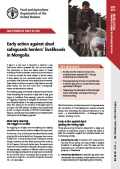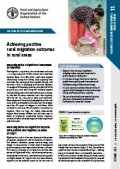FAO Agricultural Development Economics Policy Briefs
About the series (ISSN 2520-6540)
The FAO Agricultural Development Economics Policy Briefs series covers policy messages and recommendations from across the Agricultural Development Economics Division focusing on different themes, such as food security and nutrition global trends and governance; food security and resilience; sustainable markets, agribusinesses and rural transformations; and climate-smart agriculture
FAO Agricultural Development Economics Policy Brief 19
Policy brief, 2019
Food loss and waste reduction is considered important for improving food security and nutrition, promoting environmental sustainability and lowering production costs. However, it is not a given that reducing food loss and waste in any...
Available in:English
FAO Agricultural Development Economics Policy Brief 18
Policy brief, 2019
The high cost to Ecuador’s national budget of maintaining a minimum guaranteed producer price for rice led to the introduction of a price bracket system in 2017. The minimum support price policy and a complimentary...
Available in:English
FAO Agricultural Development Economics Policy Brief 17
Policy brief, 2019
This policy brief analyses Ecuador’s trade, productive and price policies for maize and their effect on farmers’ level of protection. The minimum support price enacted until 2017, turned out to be a non-operative policy due...
Available in:English
FAO Agricultural Development Economics Policy Brief 16
Policy brief, 2019
Uganda is one of the largest refugee hosting countries in Africa, with more than 1.1 million refugees. The Uganda Refugee Policy (2006) and the Refugee Regulations (2010) grant refugees wide-ranging rights hinged on a strategy...
Available in:English
FAO Agricultural Development Economics Policy Brief 15
Policy brief, 2018
This policy brief analyses the outcomes of targeted early actions in Mongolia during the winter of 2017 to 2018, triggered by warnings that extreme weather posed a major risk to vulnerable livestock herders. It evaluates...
Available in:English
FAO Agricultural Development Economics Policy Brief 14
Policy brief, 2018
The brief uses a unique set of data from Zambia collected from smallholders before and after the 2015/2016 ENSO event, which was widely anticipated by regional and global forecast services to contribute to dry conditions...
Available in:English
FAO Agricultural Development Economics Policy Brief 13
Policy brief, 2018
Many different policies affect rural migration through their impacts on agriculture, rural development, food insecurity and poverty. As countries at different levels of development face different challenges and policy priorities (as shown in the typology...
Available in:English
FAO Agricultural Development Economics Policy Brief 12
Policy brief, 2018
Contrary to popular belief, development is more likely to increase rather than reduce emigration from countries at lower levels of income. The notion that better economic opportunities at home will reduce the incentive to migrate...
Available in:English
FAO Agricultural Development Economics Policy Brief 11
Policy brief, 2018
Migration from rural areas is significant, and policy-makers must seek to maximize its positive impacts on development. The movement of people out of agriculture and into other sectors with higher productivity – manufacturing and services,...
Available in:English
FAO Agricultural Development Economics Policy Brief 10
Policy brief, 2018
Kyrgyzstan experienced an extremely cold winter in 2012, with heavy snowfall followed by a significant spring run-off. This harsh winter led to considerable livestock mortality and price rises for animal products, with a substantial impact...
Available in:English










